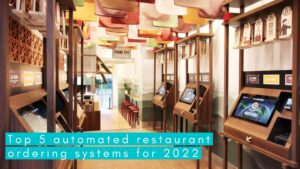Inclusivity has evolved with technology, and vice versa. Together, they’ve created accessible spaces and opportunities for QSR customers, enhancing their dining experiences and making them feel welcomed and comfortable.
Automation and AI have played a huge role in delivering customers more ways than ever to order and access their favorite foods, like the drive-thru.
There’s just one problem… not every customer speaks English, so there is a huge opportunity for voice AI with multi-language support capabilities in QSRs. Secondly, the drive-thru isn’t a perfect test environment – it’s loud, busy, and full of customers with different dialects and accents, creating a perfect storm for inaccuracies and miscommunication.
So, how can QSRs use AI to provide accessible, interactive, and inclusive service to every customer while maintaining the high standards of accuracy and quality they expect?
What Does Inclusivity Even Mean?
AI provides a vast scope of opportunity for businesses in the food service industry to create an enhanced customer experience. A great place to start is by developing a DEI framework and using it to identify where AI and automation can improve processes.
- Diversity (D): The presence of people from different ethnicities, races, and socioeconomic backgrounds who visit your QSR. It also refers to gender, physical ability, parental status, and more.
- Equity (E): Creating processes to ensure every diner receives fair, impartial, and equal treatment.
- Inclusion (I): Fostering a sense of belonging and support in your QSR ensures every customer and employee feels welcome and comfortable.
Why Inclusivity is Needed Now More Than Ever
When we use technology for good, great things happen – and here’s why the QSR industry needs to keep striving for inclusivity using tech.
Better Accessibility
From home assistants like Alexa that support elderly people and voice-to-text solutions aiding visually impaired students, voice technology is widely used in society to help people get by.
Conversational AI technology is a game-changer, helping diners enjoy a simple and accessible ordering experience. While voice AI has made leaps and bounds of progress with accuracy (for example, Hi Auto can handle multiple requests, accents, and mid-sentence changes), there’s been one lingering hurdle: language support.
There are 43.5 million Spanish speakers in America, which highlights a huge opportunity to provide accessible service to this demographic of customers. In a breakthrough for Spanish-speaking and bilingual communities, Checkers and Rally’s (in partnership with Auto) deployed Spanish-language voice ordering AI at the drive-thrus of more than 350 restaurants across the US.
You can make changes inside your QSR, too. Small tweaks to your self-service kiosks can make a big difference to the accessibility of your QSR. Using an interface with adjustable font sizes and adding a braille display to your self-service kiosks creates a much easier in-store ordering experience for diners.
Order Customization
When it comes to order customization, it’s not always about preference – sometimes, it’s about necessity. Diners with dietary requirements or allergies need the flexibility and accessibility to carefully choose their items.
One way to do this is by displaying customization options clearly on the screens of in-store kiosks, enabling diners to read ingredient or allergen information and order exactly what they want or need. Don’t forget to invest in your order accuracy, too – there’s no room for error in any order, especially not when allergies are concerned.
The Wendy’s chain is well-known for its expansive customization options, creating billions of possible order combinations for hungry diners. Recently, Wendy’s partnered with Google Cloud to create Wendy’s FreshAI, a new voice ordering system designed to take the complexity out of the drive-thru ordering process – despite the highly complex menu.
It’s no small feat. While the prospect of billions of order combinations excites customers, it also leaves room for miscommunication and incorrect orders. To combat these risks, FreshAI is built on Google’s foundational large language models (LLMs) and is trained on a massive amount of Wendy’s menu data.
While Wendy’s are now making leaps towards becoming more accessible and modern with their AI approach, the Google technology is in its very early stages. Hi Auto has already hit the ground running to create a more seamless experience for all customers, and Auto is being used in hundreds of restaurants and QSRs already.
Reduced Bias
Customers expect three main things from your QSR: speed, convenience, and great food. But focusing too much on these quantifiable metrics means you might miss the bigger picture – how do your customers feel when visiting your restaurant?
The great thing about AI is that it’s customizable, so a voice ordering system can greet every customer and deliver a high-quality and friendly service every single time – even if it’s been working for 24 hours straight. This personalization capability creates an inclusive and interactive customer experience, which helps your guests feel welcomed and comfortable, knowing that your QSR prioritizes accessibility.
How Automation Can Serve Up Inclusivity Alongside Your Combo Meal
The amazing thing about automation is that it takes the strain off your employees, leaving them with more time for customer service and supporting your diners with their needs.
Digital Menus
Reading small paper menus can be difficult for visually impaired customers, not to mention it’s pretty old-school. You can put large digital menu boards in suitable positions for customers to see, plus they provide plenty of light, different font sizes, and images.
Contactless Payments
Offering a range of payment options, including cash and card, helps you appeal to more diners, but contactless is a must-do for safety and hygiene reasons. After all, the pandemic wasn’t too long ago.
For example, for diners with low immune systems or sick family members, touchless experiences (like the combination of voice ordering and contactless payments) are essential.
Different Ordering Options
We’ve already discussed how kiosks and self-service stations provide a simple way for diners to choose the right items themselves and read information about your products. Some diners need or want to stay home, so online and mobile ordering gives them access to your QSR from a comfortable location.
AI and Real-time Support
AI automatically detects the language the customer speaks and immediately responds in that language to carry out the ordering process.
The real-time translation and Spanish language support offered by Auto is a huge step towards an easier, more accessible, and, most importantly, more enjoyable ordering experience for the almost 50 million Spanish-speaking customers in the US.
In light of the ongoing labor crisis in the restaurant industry, AI significantly supports your employees and customers, especially if you don’t have a multilingual workforce.
Next in Line at the Drive-Thru
We’re just scratching the surface with the possibilities of technology for inclusivity in the QSR industry. Running a successful QSR business isn’t just about sales, numbers, and, well, burgers – it’s also about caring for your customers and making sure everyone feels welcome and included.
Contact us today to discover what multilingual and advanced voice ordering AI can do for your QSR.





